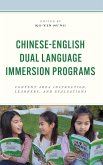Teaching and Learning Chinese as a Second or Foreign Language
Emerging Trends
Herausgeber: Sung, Ko-Yin
Teaching and Learning Chinese as a Second or Foreign Language
Emerging Trends
Herausgeber: Sung, Ko-Yin
- Gebundenes Buch
- Merkliste
- Auf die Merkliste
- Bewerten Bewerten
- Teilen
- Produkt teilen
- Produkterinnerung
- Produkterinnerung
This edited collection, with a focus on Chinese as a second or foreign language acquisition, consists of research studies that address one of three emerging themes: information and communication technology (ICT), young learners, and Chinese-character teaching and learning.
Andere Kunden interessierten sich auch für
![Education and Language in the Philippines Education and Language in the Philippines]() Lorraine Pe SymacoEducation and Language in the Philippines39,99 €
Lorraine Pe SymacoEducation and Language in the Philippines39,99 €![Education and Language in the Philippines Education and Language in the Philippines]() Lorraine Pe SymacoEducation and Language in the Philippines92,99 €
Lorraine Pe SymacoEducation and Language in the Philippines92,99 €![Bilingualism and Language Pedagogy Bilingualism and Language Pedagogy]() Bilingualism and Language Pedagogy88,99 €
Bilingualism and Language Pedagogy88,99 €![Chinese-English Dual Language Immersion Programs Chinese-English Dual Language Immersion Programs]() Chinese-English Dual Language Immersion Programs106,99 €
Chinese-English Dual Language Immersion Programs106,99 €![Language, Space and Power Language, Space and Power]() Samina Hadi-TabassumLanguage, Space and Power119,99 €
Samina Hadi-TabassumLanguage, Space and Power119,99 €![Understanding Bilingualism, Bilinguality, and Bilingual Education in an Era of Globalization Understanding Bilingualism, Bilinguality, and Bilingual Education in an Era of Globalization]() Ai-Ling WangUnderstanding Bilingualism, Bilinguality, and Bilingual Education in an Era of Globalization175,99 €
Ai-Ling WangUnderstanding Bilingualism, Bilinguality, and Bilingual Education in an Era of Globalization175,99 €![Language, Space and Power Language, Space and Power]() Samina Hadi-TabassumLanguage, Space and Power37,99 €
Samina Hadi-TabassumLanguage, Space and Power37,99 €-
-
-
This edited collection, with a focus on Chinese as a second or foreign language acquisition, consists of research studies that address one of three emerging themes: information and communication technology (ICT), young learners, and Chinese-character teaching and learning.
Produktdetails
- Produktdetails
- Verlag: Lexington Books
- Seitenzahl: 250
- Erscheinungstermin: 23. Oktober 2019
- Englisch
- Abmessung: 235mm x 157mm x 19mm
- Gewicht: 562g
- ISBN-13: 9781498574792
- ISBN-10: 1498574793
- Artikelnr.: 57582224
- Herstellerkennzeichnung
- Libri GmbH
- Europaallee 1
- 36244 Bad Hersfeld
- gpsr@libri.de
- Verlag: Lexington Books
- Seitenzahl: 250
- Erscheinungstermin: 23. Oktober 2019
- Englisch
- Abmessung: 235mm x 157mm x 19mm
- Gewicht: 562g
- ISBN-13: 9781498574792
- ISBN-10: 1498574793
- Artikelnr.: 57582224
- Herstellerkennzeichnung
- Libri GmbH
- Europaallee 1
- 36244 Bad Hersfeld
- gpsr@libri.de
Ko-Yin Sung is associate professor of Chinese at Utah State University and coordinator of the Chinese language program.
Contents
Note on Figures
Introduction
Ko-Yin Sung
STARTALK eTower: Increasing Chinese Language and Cultural Proficiency
Through Open Access Online Technology
Dali Tan, Angela Gunder, Shaoyu Chi, and Susan PicardLearner Autonomy and
Chinese Vocabulary Learning with Technology
Yalun Zhou and Michael WeiUse Reflective Learning Model to Assess the
Effectiveness of Online Language LearningPei-ni Causarano
Empirical Studies of Teletandem between U.S. and Taiwan Universities
Yan Gao and I-Ping P. FuWhy and How Should Chinese Be Learnt? A Preliminary
Investigation regarding Italian High School Learners
Chiara RomagnoliWhy Do Children Learn Chinese? An Exploratory Study of
Parental Beliefs, Classroom Motivational Strategies, and Young Learners'
Motivated Behaviors
Xin ZhangIntegrating Content and Language Instruction in a Chinese
Immersion Classroom
Wenying ZhouUsing the Chunking Method in Teaching Chinese Characters in a
Sixth Grade Chinese Dual Language Immersion ClassroomKo-Yin Sung, Hsiao-Mei
Tsai, and I-Chiao Hung
Instructional Interventions and Character Learning Strategies: A study on
Orthographic Study Assignments Yan Xie
Exploring Chinese Character Learning by English Speakers through Error
AnalysisLan Zhang
Using Multimedia-assisted Materials to Facilitate the Self-Paced Learning
of Traditional Chinese CharactersHsiu-Jen Cheng and Hong Zhan
Which Is More Effective: APP Game or Workbook? - An Experiment on Learning
Chinese Character WritingXiaoshi Li and Wenying Zhou
DaZiBao: Multimodality in Learning and Communicating via Chinese Characters
Justin Olmanson, Xianquan Liu, Christopher C. Heselton, andAsha
SrivastavaAcquiring Chinese Character Literacy Through Student-Produced
VideosSujane Wu and Yalin Chen
Note on Figures
Introduction
Ko-Yin Sung
STARTALK eTower: Increasing Chinese Language and Cultural Proficiency
Through Open Access Online Technology
Dali Tan, Angela Gunder, Shaoyu Chi, and Susan PicardLearner Autonomy and
Chinese Vocabulary Learning with Technology
Yalun Zhou and Michael WeiUse Reflective Learning Model to Assess the
Effectiveness of Online Language LearningPei-ni Causarano
Empirical Studies of Teletandem between U.S. and Taiwan Universities
Yan Gao and I-Ping P. FuWhy and How Should Chinese Be Learnt? A Preliminary
Investigation regarding Italian High School Learners
Chiara RomagnoliWhy Do Children Learn Chinese? An Exploratory Study of
Parental Beliefs, Classroom Motivational Strategies, and Young Learners'
Motivated Behaviors
Xin ZhangIntegrating Content and Language Instruction in a Chinese
Immersion Classroom
Wenying ZhouUsing the Chunking Method in Teaching Chinese Characters in a
Sixth Grade Chinese Dual Language Immersion ClassroomKo-Yin Sung, Hsiao-Mei
Tsai, and I-Chiao Hung
Instructional Interventions and Character Learning Strategies: A study on
Orthographic Study Assignments Yan Xie
Exploring Chinese Character Learning by English Speakers through Error
AnalysisLan Zhang
Using Multimedia-assisted Materials to Facilitate the Self-Paced Learning
of Traditional Chinese CharactersHsiu-Jen Cheng and Hong Zhan
Which Is More Effective: APP Game or Workbook? - An Experiment on Learning
Chinese Character WritingXiaoshi Li and Wenying Zhou
DaZiBao: Multimodality in Learning and Communicating via Chinese Characters
Justin Olmanson, Xianquan Liu, Christopher C. Heselton, andAsha
SrivastavaAcquiring Chinese Character Literacy Through Student-Produced
VideosSujane Wu and Yalin Chen
Contents
Note on Figures
Introduction
Ko-Yin Sung
STARTALK eTower: Increasing Chinese Language and Cultural Proficiency
Through Open Access Online Technology
Dali Tan, Angela Gunder, Shaoyu Chi, and Susan PicardLearner Autonomy and
Chinese Vocabulary Learning with Technology
Yalun Zhou and Michael WeiUse Reflective Learning Model to Assess the
Effectiveness of Online Language LearningPei-ni Causarano
Empirical Studies of Teletandem between U.S. and Taiwan Universities
Yan Gao and I-Ping P. FuWhy and How Should Chinese Be Learnt? A Preliminary
Investigation regarding Italian High School Learners
Chiara RomagnoliWhy Do Children Learn Chinese? An Exploratory Study of
Parental Beliefs, Classroom Motivational Strategies, and Young Learners'
Motivated Behaviors
Xin ZhangIntegrating Content and Language Instruction in a Chinese
Immersion Classroom
Wenying ZhouUsing the Chunking Method in Teaching Chinese Characters in a
Sixth Grade Chinese Dual Language Immersion ClassroomKo-Yin Sung, Hsiao-Mei
Tsai, and I-Chiao Hung
Instructional Interventions and Character Learning Strategies: A study on
Orthographic Study Assignments Yan Xie
Exploring Chinese Character Learning by English Speakers through Error
AnalysisLan Zhang
Using Multimedia-assisted Materials to Facilitate the Self-Paced Learning
of Traditional Chinese CharactersHsiu-Jen Cheng and Hong Zhan
Which Is More Effective: APP Game or Workbook? - An Experiment on Learning
Chinese Character WritingXiaoshi Li and Wenying Zhou
DaZiBao: Multimodality in Learning and Communicating via Chinese Characters
Justin Olmanson, Xianquan Liu, Christopher C. Heselton, andAsha
SrivastavaAcquiring Chinese Character Literacy Through Student-Produced
VideosSujane Wu and Yalin Chen
Note on Figures
Introduction
Ko-Yin Sung
STARTALK eTower: Increasing Chinese Language and Cultural Proficiency
Through Open Access Online Technology
Dali Tan, Angela Gunder, Shaoyu Chi, and Susan PicardLearner Autonomy and
Chinese Vocabulary Learning with Technology
Yalun Zhou and Michael WeiUse Reflective Learning Model to Assess the
Effectiveness of Online Language LearningPei-ni Causarano
Empirical Studies of Teletandem between U.S. and Taiwan Universities
Yan Gao and I-Ping P. FuWhy and How Should Chinese Be Learnt? A Preliminary
Investigation regarding Italian High School Learners
Chiara RomagnoliWhy Do Children Learn Chinese? An Exploratory Study of
Parental Beliefs, Classroom Motivational Strategies, and Young Learners'
Motivated Behaviors
Xin ZhangIntegrating Content and Language Instruction in a Chinese
Immersion Classroom
Wenying ZhouUsing the Chunking Method in Teaching Chinese Characters in a
Sixth Grade Chinese Dual Language Immersion ClassroomKo-Yin Sung, Hsiao-Mei
Tsai, and I-Chiao Hung
Instructional Interventions and Character Learning Strategies: A study on
Orthographic Study Assignments Yan Xie
Exploring Chinese Character Learning by English Speakers through Error
AnalysisLan Zhang
Using Multimedia-assisted Materials to Facilitate the Self-Paced Learning
of Traditional Chinese CharactersHsiu-Jen Cheng and Hong Zhan
Which Is More Effective: APP Game or Workbook? - An Experiment on Learning
Chinese Character WritingXiaoshi Li and Wenying Zhou
DaZiBao: Multimodality in Learning and Communicating via Chinese Characters
Justin Olmanson, Xianquan Liu, Christopher C. Heselton, andAsha
SrivastavaAcquiring Chinese Character Literacy Through Student-Produced
VideosSujane Wu and Yalin Chen









